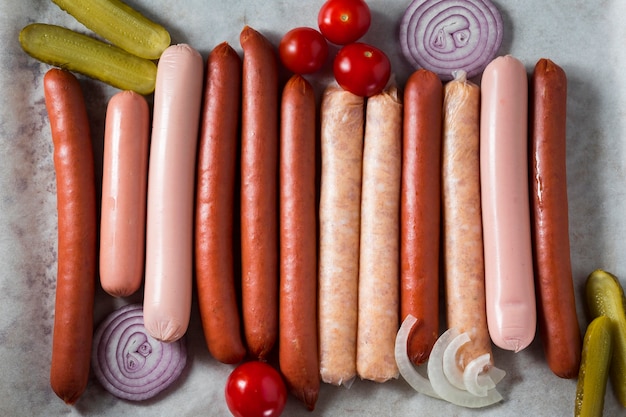Let's be honest, we've all been there. It's a Tuesday night, you're famished, and the only thing in your freezer is a pack of frozen sausages. You know you need to cook them, but the idea of turning those frozen lumps into something delicious feels daunting. Fear not, my fellow sausage enthusiasts, because I'm here to share my hard-earned wisdom (and a few burnt-sausage tales) on how to cook frozen sausages to perfection, every single time.
This guide is your one-stop shop for all things frozen sausage, from the basics to more adventurous techniques. We'll cover everything from proper defrosting (no microwave disasters here!), to the best cooking methods, whether it's pan-frying, grilling, or oven-baking. We'll explore flavour-enhancing tips, address common sausage-cooking mishaps, and finally, tackle the question that haunts us all: how do you know if your sausage is truly cooked through?
Ready to elevate your frozen sausage game? Let's dive in!
(Part 1) The Great Sausage Defrost

The Importance of a Proper Defrost
You might be tempted to skip the defrosting step entirely and just chuck those frozen sausages straight into the pan. But trust me, it's a recipe for disaster. You'll end up with tough, rubbery sausages that no one wants to eat.
Think of it this way: defrosting allows the moisture to distribute evenly throughout the sausage, resulting in a juicy, tender sausage with that satisfying, crispy bite. So, even if you're in a rush, take the time to defrost properly.
The No-Microwave Method
As much as I love the speed of the microwave, I'm not a fan of microwaving sausages. It just feels wrong, and the results can be unevenly cooked. My go-to method is the tried-and-true fridge defrost.
Simply transfer your frozen sausages from the freezer to the fridge.
Let them chill out there for 12-24 hours, depending on the size of the sausages.
Once they're fully thawed, you're good to go!
The Cold Water Immersion Method
If you're in a real pinch and need your sausages defrosted quickly, the cold water immersion method can be a lifesaver. It's a bit riskier, though, so keep a close eye on them.
Place your frozen sausages in a bowl filled with cold water.
Change the water every 30 minutes or so to ensure it stays cold.
This method typically takes about 30 minutes to an hour, depending on the size of the sausages.
Tip: The Ziplock Bag Hack
For the cold water method, I always put my sausages in a resealable ziplock bag before submerging them in water. This prevents them from getting waterlogged and helps keep the water clean.
(Part 2) The Pan-Frying Phenomenon

The Classic Approach
Pan-frying is the go-to method for most sausage lovers. It's simple, reliable, and delivers that glorious crispy skin.
Heat a large pan over medium heat.
Add a tablespoon or two of oil or butter, ensuring it coats the bottom of the pan.
Once the oil is shimmering, gently place your sausages in the pan, leaving a bit of space between each one.
Let them cook undisturbed for about 5-7 minutes per side, or until golden brown and crispy.
You might need to lower the heat slightly to prevent burning.
Once cooked through (we'll get to that in a bit), remove them from the pan and drain on kitchen paper.
Pro Tip: The Sizzle Test
A good sizzle is your friend! You'll know your pan is ready when you hear that satisfying sound when you drop a sausage into the oil. It indicates the pan is hot enough for a good sear.
The Blistering Technique
For an extra intense flavour and extra crispy skin, try the blistering technique. It's a bit more involved, but the results are truly worth it.
Heat your pan over high heat.
Add a splash of oil.
Once the oil is smoking hot, carefully place your sausages in the pan.
They will start to blister almost immediately, so keep a close eye on them!
Use tongs to flip them every couple of minutes.
Once the sausages are browned all over and blistered, reduce the heat to medium-low and continue cooking until they're cooked through.
Tip: The Water Splash Trick
If your sausages are sticking to the pan, add a splash of water. The steam will help loosen them up and prevent burning.
(Part 3) Grilling Glory

The Art of Outdoor sausage cooking
Ah, the grill. There's something about that smoky flavour that elevates the sausage experience, especially during the warmer months.
Preheat your grill to medium-high heat.
Clean the grill grates and lightly oil them to prevent sticking.
Place your sausages on the grill, leaving a bit of space between them.
Close the lid and cook for about 10-12 minutes, flipping them halfway through.
Keep a close eye on them to ensure they don't burn.
The Indirect Heat Trick
For a more even cook, try the indirect heat method.
Place the sausages on one side of the grill, away from the direct heat.
Close the lid and cook for about 15-20 minutes, flipping them halfway through.
Tip: The Grill Brush
A good grill brush is essential for cleaning your grill grates. It prevents sticking and ensures your sausages cook evenly.
(Part 4) Oven-Baked Goodness
The No-Fuss Approach
Oven-baking is a great option if you want to cook a large batch of sausages or prefer a less hands-on method.
Preheat your oven to 375°F (190°C).
Place your sausages on a baking sheet lined with parchment paper.
Roast for about 20-25 minutes, flipping them halfway through, or until they're cooked through.
Tip: The Roasting Rack
Using a roasting rack will ensure your sausages cook evenly and get that crispy skin.
(Part 5) The Sausage-Cooking Commandments
1. Don't Overcrowd the Pan
Give your sausages some space! If you crowd them together, they'll steam instead of sear, and you won't get that lovely crispy skin.
2. Use a Thermometer
If you're unsure whether your sausages are cooked through, use a meat thermometer. They should reach an internal temperature of 160°F (71°C). This is the only way to be absolutely sure they are safe to eat.
3. Don't Poke and Prod
Resist the urge to poke and prod your sausages while they're cooking. This will release all the juices and make them dry.
4. Let Them Rest
Once your sausages are cooked, let them rest for a few minutes before serving. This allows the juices to redistribute, resulting in a more flavorful and tender sausage.
(Part 6) The Flavour Factor
spices and herbs
Don't be afraid to get creative with your sausage seasonings. I love adding a pinch of smoked paprika, a sprinkle of cayenne pepper, or a sprig of rosemary for extra flavour.
Sauces and Glazes
A good sauce or glaze can elevate your sausage game to a whole new level. Try a classic barbecue sauce, a tangy mustard glaze, or even a sweet and spicy honey-sriracha sauce.
Tip: The Finishing Touches
Before serving, add some finishing touches like chopped fresh herbs, a drizzle of balsamic vinegar, or a squeeze of lemon juice.
(Part 7) The sausage sideshow
Classic Sausage Sides
mashed potatoes: A classic combination that never fails.
Roasted vegetables: Add some colour and flavour with roasted carrots, Brussels sprouts, or asparagus.
Sautéed onions and peppers: A simple but satisfying side dish.
Beyond the Basics
Salad: A lighter and refreshing option, especially during the warmer months.
Bread and butter: A simple but satisfying accompaniment.
Rice: A versatile option that can be seasoned with herbs and spices.
(Part 8) The Sausage Connoisseur's Guide to Telling If They're Cooked Through
The Look Test
When your sausages are cooked through, they will have a slightly darker colour and a crispy skin.
The Touch Test
If you're unsure, gently poke the sausage with a fork. If the juices run clear, it's cooked through. If they're pink or red, they need more time.
The Sizzle Test (Again)
If the sausages are still sizzling in the pan, they need more time. Once they've stopped sizzling, they're likely done.
(Part 9) The Sausage-Cooking Mishaps We've All Made
The Burnt Sausage Tragedy
We've all been there. You're distracted, maybe engrossed in a good TV show, and suddenly, a plume of smoke fills the kitchen. Remember, constant vigilance is key to preventing burnt sausages!
The Undercooked Nightmare
This is where the meat thermometer is your best friend. There's nothing worse than biting into a raw sausage, so don't be afraid to check the temperature.
The Soggy Sausage Debacle
Sometimes, your sausages can end up a bit soggy. This usually happens if you've crowded them in the pan or overcooked them.
Tip: The Second-Chance Sausage
If your sausages are a little soggy, you can try crisping them up again in a dry pan over medium-high heat.
(Part 10) FAQs
1. Can I cook frozen sausages directly?
Technically, yes. But it's not recommended. Cooking frozen sausages directly will result in uneven cooking and a tough texture.
2. How do I tell if my sausage is done?
The best way to tell is by using a meat thermometer. The internal temperature should reach 160°F (71°C). You can also check for a slightly darker colour, crispy skin, and clear juices.
3. What's the best way to store leftover cooked sausages?
Let them cool completely, then store them in an airtight container in the refrigerator for up to 3-4 days.
4. Can I freeze cooked sausages?
Yes, you can. Just let them cool completely, then store them in a freezer-safe container or bag for up to 3 months.
5. What are some fun and creative ways to use cooked sausages?
You can add them to salads, pasta dishes, or even use them to make sausage rolls or other savoury pastries.
(Part 11) Beyond the Basics: sausage varieties
Frozen sausages come in a dizzying array of flavours and styles, from classic pork sausages to more adventurous options like italian sausage, chorizo, or bratwurst. Here's a brief exploration of some popular varieties:
pork sausages
These are the most common type of sausage, typically made with ground pork, herbs, and spices. They are versatile and can be cooked in many ways.
Italian Sausage
Italian sausage, often made with a blend of pork and beef, is seasoned with fennel, garlic, and red pepper flakes. It's a delicious addition to pasta dishes, pizzas, and sandwiches.
Chorizo
Chorizo, a Spanish sausage, is typically made with pork and paprika. It comes in both mild and spicy varieties and is often used in paella and other Spanish dishes.
Bratwurst
Bratwurst, a german sausage, is usually made with pork or a blend of pork and beef and seasoned with caraway seeds and other spices. It's traditionally grilled or pan-fried and served with sauerkraut and mustard.
(Part 12) The Sausage-Cooking Journey Continues
With these tips and tricks in hand, you're well on your way to becoming a sausage-cooking master. Remember, the journey is part of the fun. Experiment with different cooking methods, flavour combinations, and side dishes. And most importantly, enjoy the delicious results of your sausage-cooking adventures!
Everyone is watching

Corn on the Cob: The Ultimate Guide to Perfectly Cooked Ears
Healthy MealsAh, corn on the cob. Just the name evokes images of sunny days, barbecues, and that sweet, juicy flavour that ...

Perfect Pork Roast Oven Cooking Time: A Guide to Delicious Results
Healthy MealsThere's something truly satisfying about a perfectly roasted pork. The aroma alone is enough to make your mout...

Ham Cooking Time: How Long to Bake, Smoke, or Boil a Delicious Ham
Healthy MealsAh, ham. It's a classic, isn't it? A real crowd-pleaser, especially around holidays. And when done right, it'...

Scallops: The Ultimate Guide to Perfect Cooking
Healthy MealsAh, scallops. Those delicate, sweet, and utterly delicious morsels of the sea. They hold a special place in my...

Spaghetti Squash: The Ultimate Guide to Cooking and Serving
Healthy MealsRemember that time you saw spaghetti squash at the supermarket, looking all bumpy and strange, and thought, "W...
